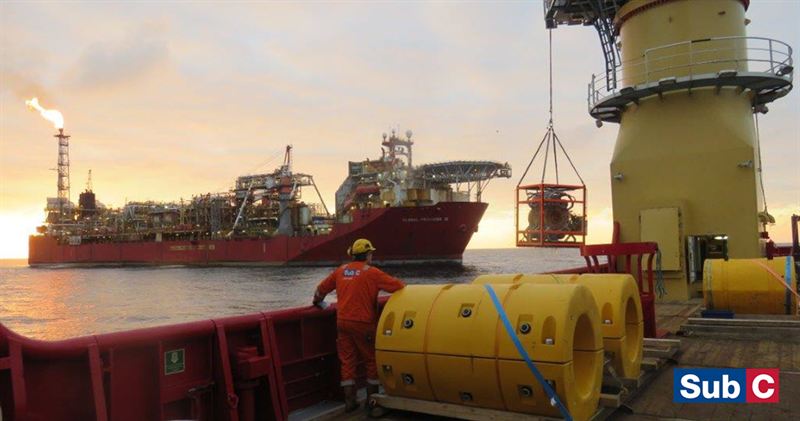Collaboration Leads to First DBMs for Installation by ROVs

To meet customer demands, Trelleborg’s offshore operation collaborated with SubC Partner to design, manufacture and test a Distributed Buoyancy Module (DBM) for installation by a Remotely Operated Vehicle (ROV) on to an FPSO’s 12 inch production riser in a steep wave configuration. By having an ROV installable DBM, Trelleborg and SubC Partner were able to successfully execute a world first offshore project, which succeeded in replacing buoyancy modules on a live riser, without shutting oil production.
In floating production scenarios, pipelines such as flexible risers, cables and umbilicals are often required to be held subsea in specific geometric configurations to prevent over utilization of the system. To achieve this, one favored method is to attach discreet buoyancy modules to the outside of the pipeline. This process is usually done topside prior to the installation of the riser itself. Until now it has not been possible to attach the buoyancy on a live riser; the riser would have to be disconnected to perform the operation, causing production to stop, requiring expensive setups and significant cost in downtime.
SubC Partner works with its customers to lower cost of energy by developing innovative engineering solutions and executing well planned and efficient offshore campaigns. In this instance, to enable fitment of buoyancy on a live riser, a bespoke suite of ROV tools was developed by SubC Partner, while Trelleborg engineered a new type of buoyancy module.
Andy Smith, Customer Group Manager at Trelleborg’s offshore operation in Skelmersdale, says: “A variety of installation features and precise datum points had to be built in to the buoyancy modules to provide a known and repeatable interface between ROV installation tooling and the DBM components. Dimensional tolerances on a buoyancy element shell are generally intrinsic to the roto-molding manufacturing process. Attaining the stringent tolerances required for this project was made a success through collaboration between design, suppliers and tooling engineering.”
Lars Wigant, Director & Partner at SubC Partner commented: “Installation of the new ROV installed DBMs was a complete success. We were able to safely remove and install multiple modules in a very limited timeframe. We look forward to the next opportunity where we can use this field proven design on another project.”
Subsea Distributed Buoyancy Modules are typically used between a subsea structure and a surface vessel or platform. The clamping solution allows the DBMs to be fitted at any point along the length of the pipeline and the buoyant load must not migrate or degrade over the design life of the product. The two main functions of the DBMs are to provide uplift and maintain location along the riser.
The internal clamp to riser interface was based on a hinged version of Trelleborg’s ‘type 2’ friction clamp with nylon segments and rubber pads for added compliance The clamp had no loose components and the tightening mechanism was redesigned to suit the ROV interface. During testing, clamp performance was excellent, achieving a slip load in excess of 33 kN at ‘end of life’ condition and in prototype testing the hinged crossbars within the design meant that the fastener tightening was tolerant of a variance in tightening sequence.
In addition, buoyancy element fasteners, the mechanism that holds the two buoyancy halves together, had to be captive. To accomplish this, Trelleborg opted to make use of a bolted flange tightening system instead of circumferential securing straps and tensioners. This presented a challenge by increasing the risk potential for buoyancy element misalignment when elements were paired. To overcome this bespoke ‘floating’ nuts and bolts were used. The ‘floating’ nuts self-aligned upon engagement, ensuring every buoyancy element was aligned correctly and secured.
For press information or additional information on Trelleborg Offshore solutions, contact Ruth Clay, Direct: 18324568308, Mobile: 1 281 740 5755; ruth.clay@trelleborg.com, @OffshoreInsight, LinkedIn.
Trelleborg’s offshore operation and Trelleborg Group
Using advanced polymer material technology, Trelleborg’s offshore operation provides high integrity solutions for the harshest and most demanding offshore environments. As part of the Trelleborg Offshore & Construction Business Area of Trelleborg Group, Trelleborg’s offshore operation specializes in the development and production of polymer and syntactic foam based seismic, marine, buoyancy, cable protection and thermal insulation products, as well as rubber-based passive and active fire protection solutions for the offshore industry. Within its portfolio are some long established and respected brands including, CRP, OCP, Viking and Emerson & Cuming. Trelleborg’s offshore operation has been providing innovative solutions to the industry for over 30 years. www.trelleborg.com/offshore
Trelleborg is a world leader in engineered polymer solutions that seal, damp and protect critical applications in demanding environments. Its innovative solutions accelerate performance for customers in a sustainable way. The Trelleborg Group has annual sales of SEK 30 billion (EUR 3.25 billion, USD 3.60 billion) in over 40 countries. The Group comprises five business areas: Trelleborg Coated Systems, Trelleborg Industrial Solutions, Trelleborg Offshore & Construction, Trelleborg Sealing Solutions and Trelleborg Wheel Systems, and the operations of Rubena and Savatech. The Trelleborg share has been listed on the Stock Exchange since 1964 and is listed on Nasdaq Stockholm, Large Cap. www.trelleborg.com.
Tags:


